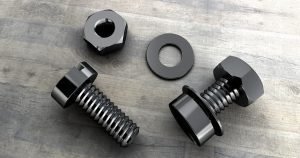
Fasteners are the mechanical components used to temporarily join two or more objects. While there are other ways to join objects — welding, brazing, adhesives, crimping, etc. — fasteners are often preferred because they can be easily removed. Threaded fasteners are particularly effective at joining multiple objects due to their threaded design. Featuring either internal or external screw threads, threaded fasteners are easy to install and equally easy to remove.
#1) Screws
The most common type of threaded fastener is a screw. Screws consist of cylindrical-shaped pieces of metal with a threaded surface wrapping around the sides. On the top of a screw is a head, which is used to drive the screw into an object or workpiece. If a screw has a Phillips head, for example, a Philips head screwdriver or bit can be used to turn and install the screw. If a screw has a flat head, on the other hand, a flat head screwdriver or bit can be used.
There are a variety of different screw types, some of which include the following:
- Machine screws
- Hex screws
- Lag screws
- Wood screws
- Drywall screws
- Concrete screws
- Self-tapping screws
#2) Nuts
Another common type of threaded fastener is a nut. Consisting of a circular-shaped piece of metal with a threaded interior surface, nuts are used in conjunction with a bolt to join two or more objects together. The threaded interior of a nut connects to the threaded exterior of a bolt. When the nut is turned, it will drive up or down the bolt depending on the direction in which it’s turned.
Although there are exceptions, most nuts feature a hexagonal exterior. The interior is still cylindrical, though the exterior features a hexagonal shape to ease the process of installation. With six sides, hexagonal nuts are easy to grip, allowing workers to install or remove them with minimal effort.
#3) Bolts
The third primary type of threaded fastener is a bolt. Some people assume bolts and screws are the same, but this isn’t true. Bolts are used to join two or more unthreaded objects, whereas screws are used to join two or more threaded objects. Keep in mind that screws often create their own threads during installation. Regardless, though, bolts are specifically designed to join unthreaded objects by relying on a nut.
As previously mentioned, nuts connect to bolts using their respective threaded surface. The threaded exterior of a bolt acts as a track for the threaded interior of a nut.
